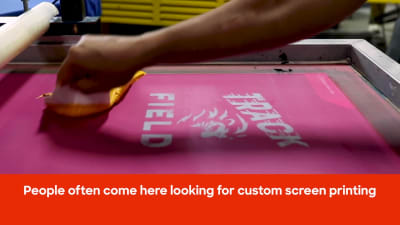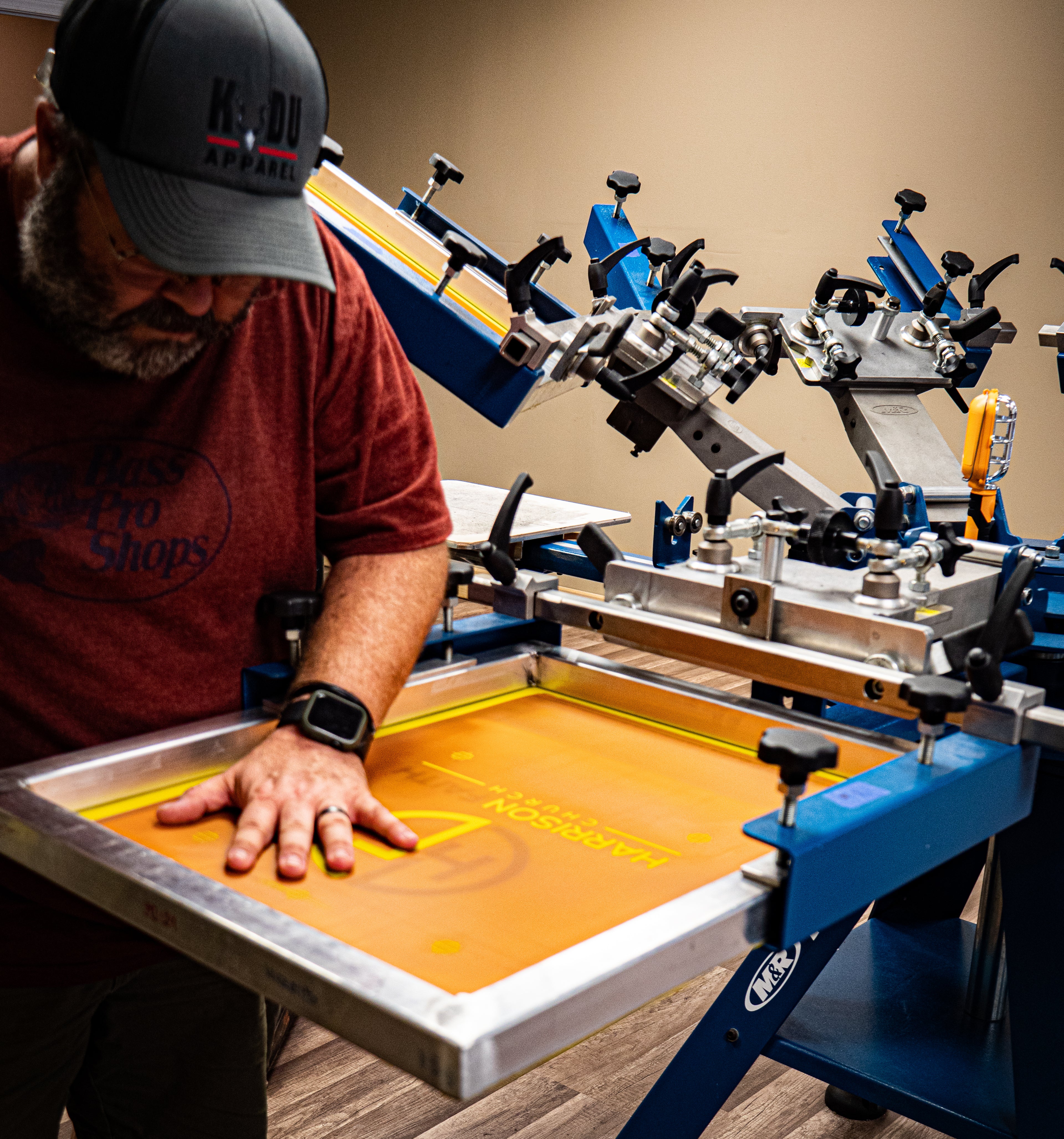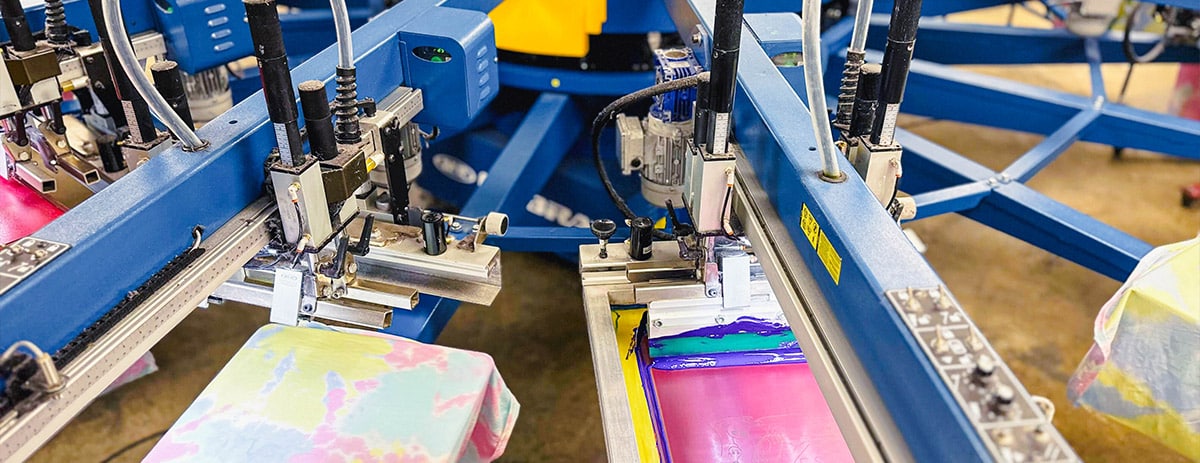Custom Screen Printing for Unique Promotional Merchandise
Custom Screen Printing for Unique Promotional Merchandise
Blog Article
Screen Printing Uncovered: Everything You Required to Learn About Tee Shirt and Garment Printing Strategies
Display printing is a fascinating technique that incorporates art with method, providing countless possibilities for creative thinking. Prepared to explore the vital elements that make screen publishing an art form?
The Basics of Display Printing: How It Functions
When you plunge into screen printing, you'll uncover it's both a science and an art. At its core, screen printing entails producing a stencil, or screen, that enables ink to pass through only in details locations.
Setting the display over the textile, after that use a squeegee to press ink via the display onto the garment. Each step is essential, and mastering them will certainly elevate your display printing skills, transforming straightforward garments right into unique, meaningful pieces.
Sorts Of Display Printing Methods
When you grasp the essentials of screen printing, it's time to check out the different strategies that can raise your designs. One prominent technique is traditional screen printing, where ink is pushed via a stenciled screen.
If you're going for great information, take into consideration discharge printing. This technique removes color from the material, leaving a soft, classic look. One more option is plastisol printing, understood for its longevity and dazzling colors, making it a favorite for many brand names. Finally, trying out halftone printing to produce slope results and elaborate styles. Each strategy has its special appeal, so don't be reluctant to try them out to discover what matches your style best!
Important Tools for Display Printing
To attain spectacular cause display printing, having the ideal equipment is basic. First, you'll need a tough display printing frame, which holds the mesh that moves your layout onto the garment. Next, invest in top notch mops; these are vital for using ink uniformly across the screen. You'll likewise require an excellent exposure system to develop your displays, in addition to a washout booth for cleaning them after use. A dependable warm source, like a conveyor clothes dryer or warmth press, is essential for treating your prints to ensure long life. Do not forget an appropriate office, equipped with tables and storage for your materials. Lastly, safety gear, such as handwear covers and masks, will certainly maintain you secure from chemicals and inks. With the right tools, you'll be well on your way to generating professional-quality prints.
Selecting the Right Inks and Products
When choosing inks and materials for screen printing, you need to consider the type of ink that functions ideal for your project. Believe about textile compatibility to ensure your layouts look last and terrific long. Explore eco-friendly ink options to make your printing process much more sustainable.
Sorts Of Display Inks
Picking the appropriate display ink is essential for achieving dynamic, sturdy prints that fulfill your job's needs. There are numerous kinds of screen inks to check out. Specialty inks, such as glow-in-the-dark or metallic, can include unique impacts to your layouts.

Material Compatibility Considerations
Recognizing fabric compatibility is essential for accomplishing high-quality screen prints, specifically because various materials respond uniquely to numerous inks. Always evaluate your inks on example fabric to assure they stick properly and preserve color honesty. Furthermore, keep in mind that material weight and texture can affect the final result, so selecting the right ink and material combo is important for your job's success.
Eco-Friendly Ink Options
Environmentally friendly inks are becoming a prominent choice for screen printers that wish to minimize their environmental effect while keeping quality. When picking inks, think about water-based inks, which are less damaging and much easier to clean up compared to typical solvents. These inks bond well with materials, providing vibrant results without harmful chemicals. You could likewise check out eco-solvent inks that use less unstable natural substances (VOCs), making them a much safer alternative for both your health and wellness and the planet.
Additionally, search for inks made from renewable energies, such as soy or vegetable-based alternatives. By picking the right inks and products, you'll not just create magnificent layouts however also add to a much more lasting printing process. Make the switch, and your prints will certainly mirror your dedication to the atmosphere!
Preparing Your Design for Display Printing

Submit Format Requirements
To guarantee your layout looks sharp and vibrant on textile, you'll require to pay close attention to submit format demands for screen printing. Make certain your style has a transparent background to prevent unwanted white edges on your prints. Maintain shade modes in mind; CMYK is common for screen printing, so transform your RGB develops as necessary.
Color Separation Strategies
Shade splitting up is a vital action in preparing your design for display printing, and understanding it can significantly improve your print quality. You'll need to damage your design into specific colors, as each shade calls for a different display during printing. Start by identifying all the colors in your design and create layers for each one. You can make use of software application like Adobe Photoshop or Illustrator to isolate and different colors efficiently. Be particular to save each layer as a different documents, typically in a style like TIFF or PSD. This precision not only guarantees accurate color representation but also enhances the printing process. By taking note of color splitting up, you'll accomplish expert and lively lead to your screen-printed garments.
Resolution and Size
Achieving the most effective cause screen printing begins with guaranteeing your style has the appropriate resolution and size. Ideally, your artwork ought to be at least 300 DPI (dots per inch) for sharp, clear prints. If you utilize reduced resolution, your last visit site product could look less than professional and pixelated.
When it comes to size, take into consideration the measurements of your print location. Layout your artwork to match the last print size, preferably producing it in the actual measurements you'll be publishing. This means, you'll avoid any unanticipated scaling problems.
Always examine your style in both vector and raster formats. Vector graphics can be scaled without losing top quality, making them ideal for screen printing. Preparing appropriately will guarantee your design looks remarkable on every garment!
Step-by-Step Display Printing Refine
Screen printing is a dynamic process that permits you to produce dynamic layouts on numerous surface areas. To obtain started, you'll need a display, emulsion, and your selected ink.
After cleaning out the unexposed solution, your display prepares. Set it up on your printing surface area and align your garment underneath it. Pour ink onto the display and use a squeegee to push the ink with the stencil onto the material. Lift the screen very carefully and let the print completely dry. Ultimately, cure the ink using warmth to assure resilience. That's it! You have actually successfully screen printed your design.
Tips for Successful Display Printing Projects
While you're diving right into your screen printing tasks, bear in mind that preparation is crucial to success. Begin by gathering all your products-- inks, garments, mops, and displays. A clean work space aids stop undesirable errors, so clean up prior to you start.
Next, verify your art work is high-resolution and effectively sized for your garment. Check your display for correct exposure and tidy it completely to avoid spots. When mixing your inks, follow the manufacturer's standards to accomplish the ideal uniformity.
Throughout printing, apply also stress with your squeegee for regular outcomes. Do not hurry; take your time to validate each print satisfies your criteria. After printing, allow your garments completely dry entirely prior to taking care of or packaging them.
Last but not least, constantly keep a sample of your benefit future recommendation. In this manner, you can analyze your progress and boost your methods gradually. Happy printing!

Frequently Asked Questions
How much time Does It Take to Establish a Screen Printing Task?
Establishing up a display printing work typically takes about half an hour to an hour. You'll prepare the screens, mix inks, and change journalism. The time varies based upon complexity and experience, so stay arranged!
Can I Print on Various Textile Keys In Utilizing the Exact Same Technique?
Yes, you can print on different textile our website types making use of the exact same technique, however you'll require to adjust your inks and setups. Some materials absorb ink in a different way, so trying out warranties the very best outcomes for each product.
What Are Usual Blunders to Avoid in Screen Printing?
When display printing, avoid usual blunders like making use of the wrong ink, overlooking appropriate direct exposure times, or missing pre-press checks. Constantly evaluate your arrangement and keep clean screens to assure top quality outcomes each time.
Exactly How Can I Correctly Clean and Maintain My Screen Printing Tools?
To properly clean and preserve your display Get More Info printing equipment, you need to consistently wash screens with appropriate solvents, inspect mops for wear, and assure all tools are stored completely dry and dust-free. Uniformity protects against costly fixings and improves efficiency.
Is Screen Printing Eco-friendly Compared to Other Methods?
Display printing can be extra eco pleasant than other methods, specifically if you use water-based inks and eco-conscious products. By choosing lasting supplies and methods, you decrease waste and decrease your influence on the earth.
Display Printing Uncovered: Everything You Need to Know Regarding Tee and Garment Printing Methods
At its core, display printing involves producing a stencil, or screen, that enables ink to pass through only in details areas. Placement the screen over the textile, after that utilize a squeegee to press ink through the display onto the garment. One preferred technique is typical display printing, where ink is pushed via a stenciled display.When choosing inks and materials for screen printing, you require to take into account the type of ink that works best for your project.
Report this page